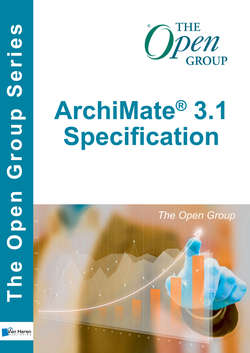Читать книгу ArchiMate® 3.1 Specification - The Open Group - Страница 10
На сайте Литреса книга снята с продажи.
ОглавлениеPreface
The Open Group
The Open Group is a global consortium that enables the achievement of business objectives through technology standards. Our diverse membership of more than 700 organizations includes customers, systems and solutions suppliers, tools vendors, integrators, academics, and consultants across multiple industries.
The mission of The Open Group is to drive the creation of Boundaryless Information Flow™ achieved by:
• Working with customers to capture, understand, and address current and emerging requirements, establish policies, and share best practices
• Working with suppliers, consortia, and standards bodies to develop consensus and facilitate interoperability, to evolve and integrate specifications and open source technologies
• Offering a comprehensive set of services to enhance the operational efficiency of consortia
• Developing and operating the industry’s premier certification service and encouraging procurement of certified products
Further information on The Open Group is available at www.opengroup.org.
The Open Group publishes a wide range of technical documentation, most of which is focused on development of Open Group Standards and Guides, but which also includes white papers, technical studies, certification and testing documentation, and business titles. Full details and a catalog are available at www.opengroup.org/library.
This Document
This document is the ArchiMate® 3.1 Specification, a standard of The Open Group. It has been developed and approved by The Open Group.
This edition of the standard includes a number of corrections, clarifications, and improvements to the previous edition, as well as several additions.
Intended Audience
The intended audience of this standard is threefold:
• All those working to shape and implement complex organization change
Typical job titles include Enterprise Architecture practitioners, Business Architects, IT architects, application architects, data architects, information architects, process architects, infrastructure architects, software architects, systems architects, solutions architects, product/service managers, senior and operational management, project leaders, and anyone working within the reference framework defined by an Enterprise Architecture.
• Those who intend to implement the ArchiMate language in a software tool
They will find a complete and detailed description of the language in this document.
• The academic community, on which we rely for amending and improving the language based on state-of-the-art research in the architecture field
Structure
The structure of this standard is as follows:
• Chapter 1, Introduction, provides the introduction to this standard, including the objectives, a brief overview, conformance requirements, and terminology
• Chapter 2, Definitions, defines the general terms used in this standard
• Chapter 3, Language Structure, describes the structure of the ArchiMate modeling language, including the top-level structure, layering, the ArchiMate Core Framework, and the ArchiMate Full Framework
• Chapter 4, Generic Metamodel, describes the structure and elements of the ArchiMate generic metamodel
• Chapter 5, Relationships, describes the relationships in the language
• Chapter 6, Motivation Elements, describes the concepts for expressing the motivation for an architecture, together with examples
• Chapter 7, Strategy Elements, provides elements for modeling the enterprise at a strategic level, together with examples
• Chapter 8, Business Layer, covers the definition and usage of the Business Layer elements, together with examples
• Chapter 9, Application Layer, covers the definition and usage of the Application Layer elements, together with examples
• Chapter 10, Technology Layer, covers the definition and usage of the Technology Layer elements, together with examples
• Chapter 11, Physical Elements, describes the language elements for modeling the physical world, together with examples
• Chapter 12, Relationships Between Core Layers, covers the relationships between different layers of the language
• Chapter 13, Implementation and Migration Elements, describes the language elements for expressing the implementation and migration aspects of an architecture (e.g., projects, programs, plateaus, and gaps)
• Chapter 14, Stakeholders, Architecture Views, and Viewpoints, describes the ArchiMate viewpoint mechanism
• Chapter 15, Language Customization Mechanisms, describes how to customize the ArchiMate language for specialized or domain-specific purposes
• Appendix A, Summary of Language Notation, is an informative appendix
• Appendix B, Relationships, is a normative appendix detailing the required relationships between elements of the language and the rules to derive these
• Appendix C, Example Viewpoints, presents a set of architecture viewpoints, developed in ArchiMate notation based on practical experience
All viewpoints are described in detail. The appendix specifies the elements, relationships, usage guidelines, goals, and target groups for each viewpoint.
• Appendix D, Relationship to Other Standards, Specifications, and Guidance Documents, describes the relationships of the ArchiMate language to other standards and specifications, including the TOGAF® framework, the BIZBOK® Guide, BPMN™, UML®, and BMM™
• Appendix E, Changes from Version 2.1 to Version 3.1, is an informative appendix outlining the changes in the standard between Version 2.1 and Version 3.1
